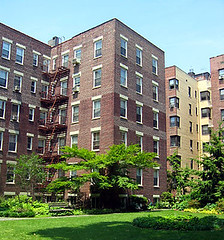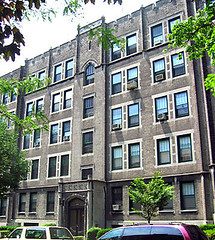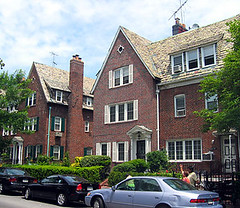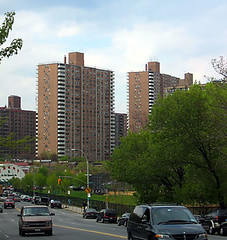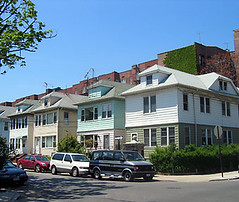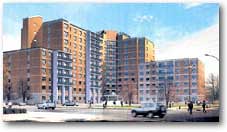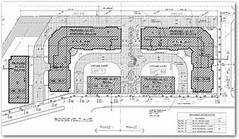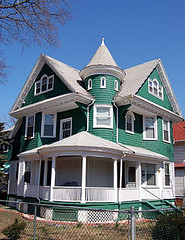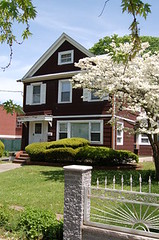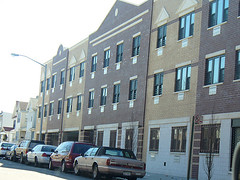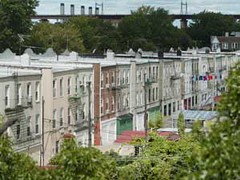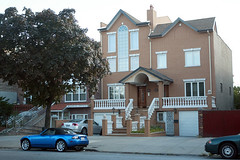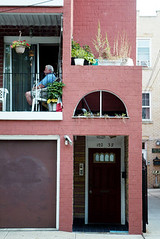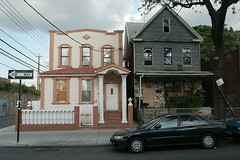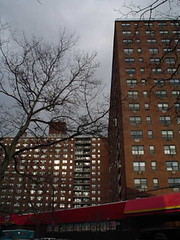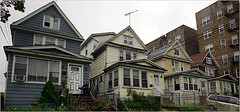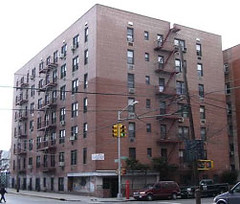|
|
HousingFrom The Peopling of New York City: Indian Communities
The defining characteristics and history of these neighborhoods is also underlined by the structural development of each area. More often than not, it is the structure of the homes that create the atmosphere of these neighborhoods that either encourage an influx of residents, especially those of immigrant origin looking for opportunity, or repel those who have the means to afford something better.
Jackson HeightsIn the 1910s and the 1920s, Jackson Heights was intended to be a community of innovative apartment buildings designed to let in light and air. The project began with large apartment buildings featuring courtyard gardens, sun rooms, parking facilities, fireplaces, high ceilings and peaked roofs, all done with a mixture of English, Dutch and Spanish styles that added up to the neighborhood's charm. Co-ops surrounded by private gardens was created to draw people in from Manhattan to settle in what had originally been farmland. These five- and six-story buildings generally offer large apartments with prewar details and bonuses like sunken living rooms and dining rooms.Most pre–World War II co-ops and homes have been landmarked and are now part of the Jackson Heights Historic District.The Greystone buildings, built in 1917, do not have interior gardens but were the first of the famous Jackson Heights co-ops. They line 80th Street between 35th and 37th Avenues in Jackson HeightsAmong the historic co-ops, there are also two and one-family English Garden homes. The outward appearance is of a one-family structure, but the upstairs could be rented out because there is an interior door and staircase. The Queensboro Corporation began construction of these private homes in 1924. Over 15 streets of English Garden homes were built. The English Garden homes are located on 70th through 73rd Streets between Northern Boulevard and 34th Avenue; on 83rd through 85th Streets between 34th and 35th Avenues; and on 86th through 88th Streets between 34th and 37th Avenues. Outside the historic district, there’s a mix of single-family homes and postwar co-op buildings. Four- to eight-story low-rise buildings dominate the heart of Jackson Heights, but one- and two-family dwellings abound as well. Low-cost row houses and co-ops can be found north of Northern Boulevard. Apartments are almost always in imposing buildings with alcove entrances and names that suggest high style such as Boswell, Colton or Princeton Court. Many have tile work on the outside. Some have pillars, and others have columns topped with lions or lamps. Most have meticulous shrubbery. There are odd stained-glass touches in some windows and small panes in nearly all the others.
FlushingAttached multiple-family homes and apartment buildings dominate the neighborhood. Near Kissena Park, there are single-family homes and south of downtown there are apartment towers. Houses come in many styles. There are English Tudors with slate roofs and turrets, Victorians, center-hall colonials, ranches and Cape Cods.[1]Flushing is developing into a residential destination. Over the last five years, projects like the Flushing Promenade, five buildings totaling 450,000 square feet of housing and shops, have turned the neighborhood into a player in housing and commercial development, with other big developments are on the horizon. The Flushing Promenade will feature a 50,000-square-foot recreation center including a swimming pool, basketball courts and an exercise room, a 200-room hotel that will feature meeting rooms and banquet halls, 500 residential units and 350,000 square feet of retail space, which will include a movie multiplex. The last two projects are expected to bring 1,500 apartments to the area.The growing Asian population has increased demand for already scarce housing and redevelopment is affecting the whole area. With the city currently redoing the streets in southern Flushing, and a swath of large detached turn-of-the-century homes zoned for six- and seven-story residential developments, the real estate boom in the area is bound to continue. The out-of-control real estate development in Flushing has led to concerns about affordable housing, landmarking, and future use of industrial areas. There are demands for down-zoning to preserve residential neighborhoods, up-zoning to allow for necessary high-density housing, and rezoning for commercial uses as longtime residents fear that they will be priced out of the market. Richmond HillRichmond Hill was one of the first suburban developments in Queens during the 19th century. It's still a large neighborhood of houses and trees, but it has become more metropolitan since. The varied influences of Richmond Hill's residents can be seen in the housing. Architecture from the Victorian era and early 1900s fills some parts, while taller apartment complexes and row houses exist elsewhere. Most modern developments there are a little less charming due to cheaper construction and fewer grand details. However, protective down-zoning preserves parts of the neighborhood from over-development which means that many homes are still originals from the 1920s and 30s.[2]
The neighborhood has three clearly defined housing zones: -North Richmond Hill is the most prosperous part, solidly middle class, with many beautiful Victorian-style homes. -The central area is more densely populated, and home to one of the largest Sikh communities outside of India. -South Richmond Hill is more working class, and dominated by the Indo-Guyanese and Trinidadian immigrant communities.AstoriaThe prominent Greek influence still resonates today, especially in the aesthetic flavor of the housing options, which consists mostly of single/multi-family homes and apartment buildings.[3] Two-story buildings are the most common housing type, blended with small apartment buildings, and one-, two-, and three-family homes, usually attached. There are more new condos under construction, but mostly small developments.
Some antebellum mansions survive and a 23-floor high-end condominium has been built on Shore Boulevard, but Astoria is mostly a mixture of six-family apartment houses and two- and three-family row houses, built after the bridges, tunnels and elevated trains of the 20th century put Astoria within easy commute of Manhattan.[4] WoodsideResidential Woodside is a mix of single-family homes, multifamily homes, and various sized apartment buildings. Other than several co-op complexes, the predominant housing is brick or frame houses for two or three families. Homes sometimes come with a small yard and a parking space in the front or back. A typical two-family house has three floors and a basement, single-family houses tend to be frame, detached or semidetached. Many rental apartments are within private homes.
Woodside's housing complexes include the nearly 12-acre, 10-building, 6-story Boulevard Gardens, a 960-unit co-op, which opened in 1935. Woodside Houses, a 1,357-unit public housing project that opened in 1949, has 20 six-story buildings across 22 acres. High-rise co-ops include the three-building, 663-unit Berkeley Towers, the two-building, 230-unit Skyview Towers and the most prominent, the seven-building, 981-unit Big Six Towers.[5]
CoronaThe residential streets north and south of Roosevelt Boulevard, which are quieter than Corona Plaza, are a patchwork of old homes and new construction, a mix of detached single/multi family homes, and larger apartment buildings located near the main avenues. Increasingly, Corona residents are seeing older houses torn down to make room for small, luxury condominiums. In addition to the new condos, there are apartments in smaller buildings and two-family houses, as well as a few single-family homes.[6]
Corona is also well-known for the million-dollar LeFrak housing project. In the 1960s, the LeFrak family created Lefrak City, the sprawling complex of 4,700 apartments and millions of square feet of commercial space on 40 acres. It was originally built for working and middle class families, and was the home of a sizeable Jewish population. Now, its main demographic is African-American and Russian/Soviet.
ElmhurstElmhurst displays a diversity of housing, which ranges from detached wood-frame houses to brick apartments. Unlike the homogeneous housing of some nearby neighborhoods, Elmhurst manages to maintain a residential feel while including a variety of housing types. Along the main commercial drags of Roosevelt Ave and Broadway, large apartment buildings loom above the bodegas and eateries, whereas on the smaller side streets single and multi-family houses are more common. The occasional blocks of early 20th-century row houses are sometimes glorious, but sometimes rundown.Most of the housing in Elmhurst is at least 40 years old, but new condos are slowly making appearances. The community is beginning to voice concerns about uncontrolled construction - even protesting the city's plans to bulldoze the beloved neighborhood library to make way for a new and improved building. As it now stands, most of the real estate are co-ops in older buildings, and 1-2 family homes.[7] Elmhurst is shaped like a square but sliced on the diagonal by Queens Boulevard. The southwestern section, near Grand Avenue, seems almost suburban, lined with modest rows of attached brick houses, with tiny gables on roofs and garages in basements. To the northeast, especially off Elmhurst Avenue, are older two- or three-family wood-frame houses, some dating from the start of the last century. There are also Art Deco apartment buildings, built as rentals in the 1930’s but converted to co-ops in the last 20 years. In Elmhurst, the teardown-overbuild trend usually involves building two multi-family homes where there used to be one. And the practice is gaining momentum unchecked, so far. Residents, though, have banded together to impose height restrictions. This particular group of residents also succeeded in pushing the city for stricter zoning for many of Elmhurst’s side streets, to keep big apartment complexes at bay in 1990.There are no housing projects in Elmhurst. |
